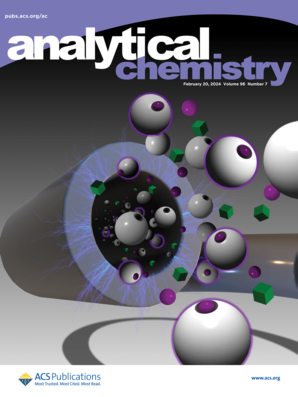Improved MALDI-MS Imaging of Polar and 2H-Labeled Metabolites in Mouse Organ Tissues
IF 6.7
1区 化学
Q1 CHEMISTRY, ANALYTICAL
引用次数: 0
Abstract
Imaging small polar metabolites and analyzing their in vivo dynamics with stable isotope-labeled (SIL) tracing through various biochemical pathways, including the citric acid (TCA) cycle, glycolysis, and amino acid metabolism, have gained substantial interest over the years. However, imaging these small polar metabolites across different tissue types is limited due to their lower ionization efficiencies and ion suppression from larger abundant biomolecules. These challenges can be further exacerbated with SIL studies, which require improvements in sample preparation and method sensitivity. Solvent pretreatments before matrix application on a tissue section have the potential to improve the sensitivity of metabolite imaging; however, they are not yet widely optimized across tissue types. Furthermore, there is a recurring concern about metabolite delocalization from such wash treatments that require “spatial validation”. Here, we optimized a simple “basic hexane” wash method that improved sensitivity up to several folds for a broad range of polar and 2H-labeled metabolites across five different mouse organ tissues (kidney, heart, brain, liver, and brown adipose tissue). Notably, we provided region-specific quantification of 51 metabolites using laser microdissection (LMD)-LC-MS/MS to validate their localization observed in MALDI-MSI analysis after the basic hexane wash. Overall, we reported an improved MALDI-MSI sample pretreatment method with a “spatial validation” workflow for sensitive and robust imaging of polar metabolite distributions in mouse organs.

小鼠器官组织中极性和2h标记代谢物的改进MALDI-MS成像
近年来,利用稳定同位素标记(SIL)追踪各种生化途径(包括柠檬酸(TCA)循环、糖酵解和氨基酸代谢)对小极性代谢物进行成像并分析其体内动力学已经引起了人们的极大兴趣。然而,这些小的极性代谢物在不同组织类型中的成像受到限制,因为它们的电离效率较低,而且来自更丰富的生物分子的离子抑制。SIL研究可能会进一步加剧这些挑战,这需要改进样品制备和方法灵敏度。在组织切片上应用基质前的溶剂预处理有可能提高代谢物成像的灵敏度;然而,它们尚未在组织类型上广泛优化。此外,对于这种需要“空间验证”的洗涤处理的代谢物脱位问题,人们经常感到担忧。在这里,我们优化了一种简单的“碱性己烷”洗涤方法,该方法将五种不同的小鼠器官组织(肾脏、心脏、大脑、肝脏和棕色脂肪组织)中广泛的极性和2h标记代谢物的敏感性提高了几倍。值得注意的是,我们使用激光显微解剖(LMD)-LC-MS/MS对51种代谢物进行了区域特异性定量,以验证在碱性己烷洗涤后MALDI-MSI分析中观察到的它们的定位。总体而言,我们报告了一种改进的MALDI-MSI样品预处理方法,该方法具有“空间验证”工作流,可对小鼠器官中极性代谢物分布进行敏感和稳健的成像。
本文章由计算机程序翻译,如有差异,请以英文原文为准。
求助全文
约1分钟内获得全文
求助全文
来源期刊

Analytical Chemistry
化学-分析化学
CiteScore
12.10
自引率
12.20%
发文量
1949
审稿时长
1.4 months
期刊介绍:
Analytical Chemistry, a peer-reviewed research journal, focuses on disseminating new and original knowledge across all branches of analytical chemistry. Fundamental articles may explore general principles of chemical measurement science and need not directly address existing or potential analytical methodology. They can be entirely theoretical or report experimental results. Contributions may cover various phases of analytical operations, including sampling, bioanalysis, electrochemistry, mass spectrometry, microscale and nanoscale systems, environmental analysis, separations, spectroscopy, chemical reactions and selectivity, instrumentation, imaging, surface analysis, and data processing. Papers discussing known analytical methods should present a significant, original application of the method, a notable improvement, or results on an important analyte.
 求助内容:
求助内容: 应助结果提醒方式:
应助结果提醒方式:


